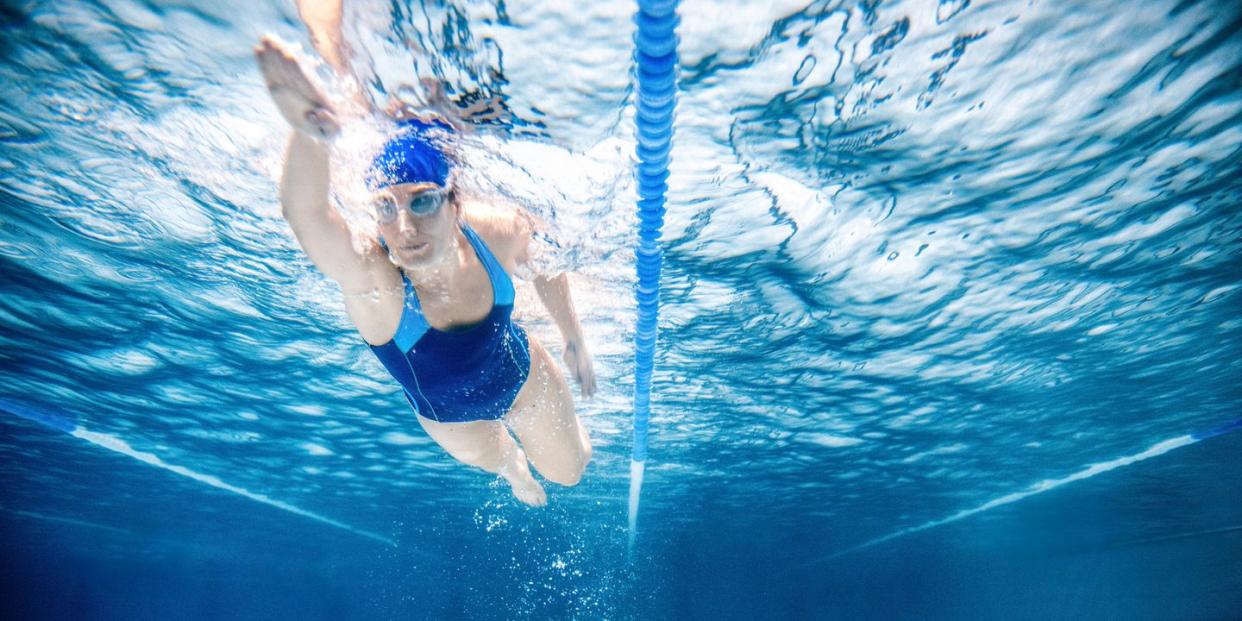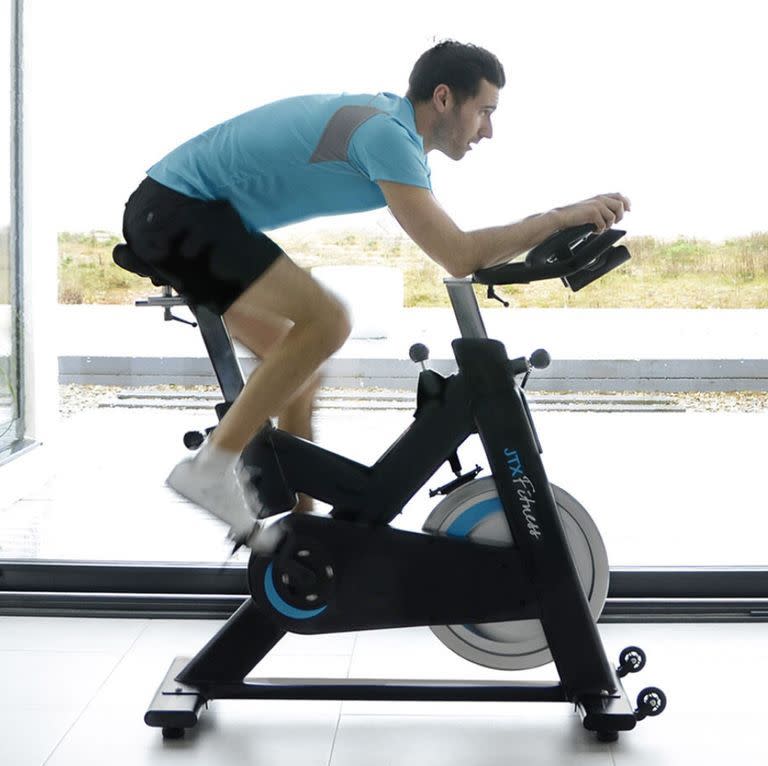The ultimate guide to cross training while injured

Runners are notoriously bad at being injured. Whether you are a recreational runner who enjoys a chatty social run or an ardent medal chaser who enjoys racing throughout the year, having your running lifeline pulled away can be incredibly frustrating and can negatively impact your mental health.
It also has an impact on your body and, over time, hard-won fitness will gradually fade away. Although rest days are vital for adaptation, too much time away from any exercise will create physiological changes. People 'atrophy' or detrain at different rates depending on factors such as their fitness level to begin with, genetics, lifestyle and nutrition.
The good news is that a few days rest has little to no impact on fitness because VO2 max and cardiac output stay relatively stable. It is only at five days to three weeks that changes occur which could impact your fitness.
'Your blood plasma volume starts to decrease, which leads to a decrease in cardiac output – in short, less oxygenated blood to your muscles,' explains coach and England Athletics running manager Tom Craggs.
The knock-on effects start to happen after around 10 days of complete rest with VO2 max reducing by 4-5%. Your body may also become less efficient at firing muscle fibers. If you do no exercise during this period then reductions in your cardiac muscle size occur and the body becomes less efficient in using glycogen.
Over a period of one to two months of no running or cross training the body becomes less efficient at burning stored fats as an energy source and it becomes more difficult to sustain high-intensity efforts.
'The body loses both capillary density and some of its ability to use oxygen to create energy in the muscles. As our mitochondria become less efficient we’ll find it harder to control the production of lactate as we train,' explains Craggs.
Over the longer term, after between three to six months of rest our body will return to a relative baselines of fitness. Depending on your level of training prior to injury, this may still be quite high compared to others.
To mitigate the early effects of detraining such as reduced blood plasma volume and cardiac muscle, cross training can provide a great way of maintaining fitness. The load will depend on the volume, intensity and frequency of the running you were doing prior to injury.
Although cross training can be an effective way to stave off fitness loss, what each runner can and cannot do will vary hugely depending on the type of injury, so make sure you seek professional medical advice first.
How do you know when to stop running?

This is a skill that definitely develops with experience. Chartered physiotherapist and running injury researcher Nathan Liddle says evidence shows that experienced runners are better at listening to their body, and know when to stop running, more effectively than their novice counterparts.
He advises using a pain scale to measure injury impact. On a pain scale of 0 (meaning no pain) to 10 (meaning maximum pain), the evidence suggests that an acceptable level of pain during exercise is around 3-4 out of 10.
'For beginner runners I would recommend the 3/10 mark as the guide, I'd tend to be slightly more cautious with this particular participant group,' says Liddle.
Another useful tip to implement is the 48-hour rule. Essentially this is checking-in with your body after each session and making a mental (or physical) note of how your body is feeling. It is common to feel some pain or discomfort as a result of exercise which is referred to as delayed onset muscle syndrome (DOMS).
'DOMS is a positive response to exercise, but it is still a very unpleasant feeling. Yet when we have some discomfort from a tough run, or a new distance for example, we can over think it and sometimes catastrophise.
'If you do have a niggle or some discomfort 24 hours after a session, don't worry about it too much and be sure not to complete any training in that 24-hour period,' advises Liddle.
Take note of how you feel the following day (48 hours after) and let this guide you. If you are feeling able to train again, great. But if the pain has not reduced dramatically (to less than 3/10) by the 48-hour point, you need another rest day. If on the third day (72 hours removed from the session) you are still suffering with pain that is more than 3/10, then you should consider seeking advice from a professional.
Why is it important to maintain fitness and strength when injured?

Maintaining fitness and strength is important for a variety of reasons. First of all, maintaining your fitness when injured will reduce the likelihood of re-injury. In terms of the stresses placed upon the body during running, the load on the cardiovascular system accounts for a significant proportion.
'If you were to de-train and lose some cardiovascular fitness, the overall load when you do return to running would spike dramatically, causing a potentially dangerous period of time where you would be more susceptible to a recurrence or new injury,' explains Liddle.
Linked to this, maintaining a level of tissue capacity in the muscles is likely to also reduce the relative spike in load at a peripheral level. 'There is a genuine rationale for training when injured to reduce the risk of re-injury or secondary injury upon returning to running,' he adds.
Additionally, strength training is an excellent supplement to training for performance. During periods of injury, we have an opportunity to undertake strength training that perhaps we wouldn't have been able to undertake if we were still running due to fatigue and available time.
'Injuries can sometimes be a window of opportunity that allow us to spend time developing areas of weakness or restriction that we may not have had the energy or time to achieve prior to being injured,' says Liddle.
What cross training activities are possible when you are injured?

There are a huge range of activities you can do whilst injured but it will depend on the type of injury. However it is important to seek professional medical advice before embarking on any cross training.
Strength work
Given the injury profile of runners, which tend to be mainly lower limb injuries, core training can be an effective mode of training and will benefit your running in the long term. Your core refers to the central part of the body and encompasses 29 pairs of muscles in total; it includes your pelvis, lower back, hips and stomach.
As our core stabilises every part of the body, it is essential to good running form and posture. If our core is strong, it means that our glutes can help keep our knees in alignment, and our hips remain level, reducing the likelihood of lower-limb injuries and improving running efficiency overall.
Upper body strength training is also a good option and something that a lot of runners tend to avoid for fear of adding extra weight, says Liddle. However, adding additional muscle tissue is incredibly difficult and requires a sustained progressive plan, with a suitable protein intake and significant calorie surplus.
'The chances of a runner adding a significant amount of upper-body muscle mass during the course of an injury would be very low. Furthermore, the overall benefits of strength training per se are so striking, that upper body training should definitely be considered when injured, as it will not load the injured tissue or affect the recovery time. Even lower body training would be appropriate in most conditions,' says Liddle.
For example, injuries such as hamstring tendinopathy usually benefit from physio-prescribed strength work because tendons do not react well to being dormant.
Cycling, elliptical and swimming
It is important to stress that the loads created from cycling, elliptical and swimming are all completely different and therefore different body parts will be stressed by performing these options.
'All these options may not be suitable for everyone but in terms of developing a cardiovascular response, they would be my go-to for runners who have access to gym facilities or their own bicycle. A trial-and-error approach may be needed as different options will be suitable for different runners and their injuries,' recommends Liddle.
Pilates and yoga
Pilates and yoga are also great options to improve flexibility and muscular endurance. If you are a runner who has restrictions in range of motion, are constantly feeling 'tight', or struggles with breathing efficiently while running, then Pilates and/or yoga are great low-impact activities to try while injured.
Both are relatively easy to access and there are some great YouTube channels with exercises you can complete in the comfort of your own home. Additionally, if you want to attend a group-based setting (if you are somebody who enjoys the camaraderie of a running group, for example), then group sessions are common in gyms and leisure centres.
Alternatively, if you have the resources and you are a bit more of an individual, you can book 1-1 sessions, but they do come with a fairly significant cost implication.
Individualised programme
Working in consultation with a personal trainer, physio or coach who knows your profile and history can offer a way of bringing all of the components above together. A qualified professional will be able to work with you to maintain and improve your physical profile while you are injured by tailoring a plan to suit your specific needs.
'If you are injured, I think it is important to work with somebody who has a sound understanding of running and running injuries, although that doesn't necessarily have to be a physiotherapist. Again, there will be cost implications with this approach as individualised support is not inexpensive, but is usually absolutely worth the cost,' says Liddle.
Suggested workouts
Liddle recommends a variety of workouts to maintain engagement in exercise and avoid the temptation to get back to running too soon.
All of the prescriptions below can be implemented on a; static bike/turbo, bicycle, elliptical trainer, stair master or rower. They can also be performed in the pool (underwater running, swimming, or water aerobics type activities), or through a bodyweight HIIT session.
All should have a suitable warm-up prior to starting the session, and a cooldown. Aim for 10-minutes on either side.
Workout 1: 4 x 4 minutes work with 2 minutes rest between sets (should be high intensity efforts)
Workout 2: 10-20 (depending on fitness level and usual distance ran) x 1 minute on with 1 minute recovery (very high intensity efforts)
Workout 3: Take the average time spent running and complete a steady-state cardiovascular session for that period of time (lower intensity and possibly more tedious than the interval options)
Workout 4: Break down the distance you run/bike/swim into interval segments. For example, for somebody who runs 10K, it would be 10 x 1km efforts under a specific time (5:55min/km for example), with 1-2 minutes rest between efforts (efforts should be medium intensity)
You Might Also Like


